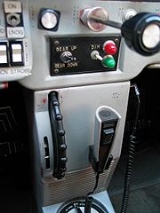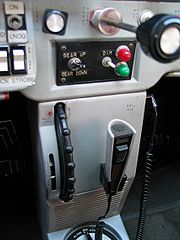
Trim tabs
Encyclopedia

Trim tabs are small surfaces connected to the trailing edge of a larger control surface
Control surface
In the domain of digital audio, a control surface is a human interface device which allows the user to control a digital audio workstation or other digital audio application. Generally, a control surface will contain one or more controls that can be assigned to parameters in the software,...
on a boat
Boat
A boat is a watercraft of any size designed to float or plane, to provide passage across water. Usually this water will be inland or in protected coastal areas. However, boats such as the whaleboat were designed to be operated from a ship in an offshore environment. In naval terms, a boat is a...
or aircraft
Aircraft
An aircraft is a vehicle that is able to fly by gaining support from the air, or, in general, the atmosphere of a planet. An aircraft counters the force of gravity by using either static lift or by using the dynamic lift of an airfoil, or in a few cases the downward thrust from jet engines.Although...
, used to control the trim of the controls, i.e. to counteract hydro- or aero-dynamic forces and stabilise the boat or aircraft in a particular desired attitude without the need for the operator to constantly apply a control force. This is done by adjusting the angle of the tab relative to the larger surface.
Changing the setting of a trim tab adjusts the neutral or resting position of a control surface (such as an elevator
Elevator (aircraft)
Elevators are flight control surfaces, usually at the rear of an aircraft, which control the aircraft's orientation by changing the pitch of the aircraft, and so also the angle of attack of the wing. In simplified terms, they make the aircraft nose-up or nose-down...
or rudder). As the desired position of a control surface changes (corresponding mainly to different speeds), an adjustable trim tab will allow the operator to reduce the manual force required to maintain that position—to zero, if used correctly. Thus the trim tab acts as a servo tab
Servo tab
A servo tab is a small hinged device installed on an aircraft control surface to assist the movement of the control surface.-Servo tabs:...
. Because the center of pressure
Center of pressure
The center of pressure is the point on a body where the total sum of a pressure field acts, causing a force and no moment about that point. The total force vector acting at the center of pressure is the value of the integrated vectorial pressure field. The resultant force and center of pressure...
of the trim tab is farther away from the axis of rotation of the control surface than the center of pressure of the control surface, the moment generated by the tab can match the moment generated by the control surface. The position of the control surface on its axis will change until the movements from the control surface and the trim surface balance each other.
Uses in boats
Boats with outboard engines will often have trim tabs attached to the lower unit of the engine. These are used to adjust the pitch attitude of the boat while underway. Changes in boat speed or weight placement will usually require the trim tabs to be adjusted to keep the boat at a comfortable and efficient pitch attitude. This reduces the work of the helmsman by reducing the amount of manual control necessary, as well as providing for greater efficiency by keeping the ship in the ideal orientation for the conditions.Trim tabs are most found on cruisers, sport fishing boats and center console boats ranging from 20 feet and up.
In some sailboats, the trailing edge of the keel has a trim tab which is used to null out rudder forces (lee or weather helm
Weather helm
Weather helm is the tendency of sailing vessels to turn towards the source of wind, creating an unbalanced helm that requires pulling the tiller to windward in order to counteract the effect. Weather helm is the opposite of Lee Helm....
).
Uses in aircraft
Many airplanes (including gliders) have trim tabs on their elevatorsElevator (aircraft)
Elevators are flight control surfaces, usually at the rear of an aircraft, which control the aircraft's orientation by changing the pitch of the aircraft, and so also the angle of attack of the wing. In simplified terms, they make the aircraft nose-up or nose-down...
, as a simple method of providing trim in the longitudinal axis.
All aircraft must have a system for ensuring trim in the longitudinal axis, though methods other than trim tabs may be used. Alternatives include:
- a spring attached to the control system that can be adjusted by the pilot
- in the case of the elevatorElevator (aircraft)Elevators are flight control surfaces, usually at the rear of an aircraft, which control the aircraft's orientation by changing the pitch of the aircraft, and so also the angle of attack of the wing. In simplified terms, they make the aircraft nose-up or nose-down...
, an all-moving horizontal stabilizer whose position can be adjusted in flight by the pilot.
Elevator trim frees the pilot from exerting constant pressure on the pitch controls. Instead, the pilot adjusts a longitudinal trim control (often in the form of a wheel) to cancel out control forces for a given airspeed / weight distribution. Typically, when this trim control is rotated forward, the nose is held down; conversely, if the trim wheel is moved back, the tail becomes "heavy." Many newer aircraft, especially jet aircraft, have electric trim controls.
Many airplanes also have rudder
Rudder
A rudder is a device used to steer a ship, boat, submarine, hovercraft, aircraft or other conveyance that moves through a medium . On an aircraft the rudder is used primarily to counter adverse yaw and p-factor and is not the primary control used to turn the airplane...
and/or aileron
Aileron
Ailerons are hinged flight control surfaces attached to the trailing edge of the wing of a fixed-wing aircraft. The ailerons are used to control the aircraft in roll, which results in a change in heading due to the tilting of the lift vector...
trim systems. On some of these, the rudder trim tab is rigid but adjustable on the ground by bending: it is angled slightly to the left (when viewed from behind) to lessen the need for the pilot to push the rudder pedal constantly to overcome the left-turning tendencies of some prop-driven aircraft. Other aircraft have hinged rudder trim tabs that the pilot can adjust in flight.
When a trim tab is employed, it is moved into the slipstream opposite to the control surface's desired deflection. For example, in order to trim an elevator to hold the nose down, the elevator's trim tab will actually rise up into the slipstream. The increased pressure on top of the trim tab surface caused by raising it will then deflect the entire elevator slab down slightly, causing the tail to rise and the aircraft's nose to move down. In the case of an aircraft where deployment of high-lift devices (flaps
Flap (aircraft)
Flaps are normally hinged surfaces mounted on the trailing edges of the wings of a fixed-wing aircraft to reduce the speed an aircraft can be safely flown at and to increase the angle of descent for landing without increasing air speed. They shorten takeoff and landing distances as well as...
) would significantly alter the longitudinal trim, a supplementary trim tab is arranged to simultaneously deploy with the flaps so that pitch attitude is not markedly changed.
The use of trim tabs significantly reduces pilots' workload during continuous maneuvers (e.g.: sustained climb to altitude after takeoff or descent prior to landing), allowing them to focus their attention on other tasks such as traffic avoidance or communication with air traffic control
Air traffic control
Air traffic control is a service provided by ground-based controllers who direct aircraft on the ground and in the air. The primary purpose of ATC systems worldwide is to separate aircraft to prevent collisions, to organize and expedite the flow of traffic, and to provide information and other...
.
Both elevator trim and pitch trim affect the small trimming part of the elevator on jet airliners. The former is supposed to be set in a certain position for a longer time, while the pitch trim (controlled with the landing pilot's thumb on the yoke or joystick, and is thereby easy to maneuver) is used all the time after the flying pilot has disabled the autopilot, especially after each time the flaps are lowered or at every change in the airspeed, at the descent, approach and final. Elevator trim is most used for controlling the attitude at cruising by the autopilot.
Beyond reducing pilot workload, proper trim also increases fuel efficiency by reducing drag
Drag (physics)
In fluid dynamics, drag refers to forces which act on a solid object in the direction of the relative fluid flow velocity...
. For example, propeller aircraft have a tendency to yaw when operating at high power, for instance when climbing: this increases parasite drag because the craft is not flying straight into the apparent wind. In such circumstances, the use of an adjustable rudder trim tab can reduce yaw.
Trim tab as a metaphor
The engineer Buckminster FullerBuckminster Fuller
Richard Buckminster “Bucky” Fuller was an American systems theorist, author, designer, inventor, futurist and second president of Mensa International, the high IQ society....
is often cited for his use of trim tabs as a metaphor for leadership and personal empowerment. In the February 1972 issue of Playboy, Fuller said:
The official newsletter of the Buckminster Fuller Institute is called "Trimtab".

